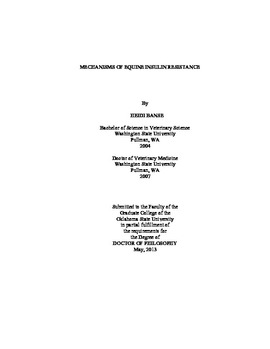| dc.contributor.advisor | McFarlane, Dianne | |
| dc.contributor.author | Banse, Heidi Elise | |
| dc.date.accessioned | 2014-09-24T14:16:26Z | |
| dc.date.available | 2014-09-24T14:16:26Z | |
| dc.date.issued | 2013-05 | |
| dc.identifier.uri | https://hdl.handle.net/11244/10957 | |
| dc.description.abstract | Equine metabolic syndrome, a condition characterized by obesity, insulin resistance (IR) or hyperinsulinemia, and laminitis is a common endocrine disorder of horses. The mechanisms responsible for the development of equine obesity-associated IR and hyperinsulinemia remain to be elucidated. Understanding of the pathophysiology of equine IR is critical for development of effective treatments. The purpose of this study was to improve understanding of mechanisms of equine IR. | |
| dc.description.abstract | Based on existing literature in other species, we initially hypothesized that oxidative stress due to mitochondrial dysfunction within skeletal muscle of obese horses causes IR. To address this, markers of oxidative stress, mitochondrial function and antioxidant capacity were evaluated in skeletal muscle of horses with and without IR. No markers of impaired mitochondrial function or oxidative damage were associated with hyperinsulinemia. Regulation of mitochondrial dynamics was altered with IR and hyperinsulinemia. | |
| dc.description.abstract | As oxidative stress did not appear to be the primary mechanism of equine IR, we hypothesized that skeletal muscle inflammation causes equine IR. Markers of inflammation were measured within skeletal muscle and systemic circulation. No positive associations between inflammation and IR or hyperinsulinemia were identified. | |
| dc.description.abstract | Because investigations into two key mechanisms of skeletal muscle insulin resistance did not reveal a likely pathogenesis of IR, investigations were redirected to a more global approach of evaluating dynamic testing techniques to assess sites of insulin dysregulation. We hypothesized that two commonly employed field tests, the oral sugar test (OST) and insulin response to dexamethasone test (IRDT) were comparable to the gold standard test of tissue insulin sensitivity, the hyperinsulinemic euglycemic clamp (HEC). The HEC was not correlated with fasting insulin concentration or results of the OST or IRDT, suggesting that tissue insulin sensitivity is not the primary determinant of field test results, and may not be the primary defect in insulin dysregulation of obese horses. | |
| dc.description.abstract | In summary, the mechanism of equine IR and hyperinsulinemia remains to be discovered. Additional investigations of dynamic testing in a population of hyperinsulinemic and normoinsulinemic horses may improve understanding of etiologies of insulin dysregulation in the horse and allow for further investigation into the pathophysiology of equine obesity-associated IR and hyperinsulinemia. | |
| dc.format | application/pdf | |
| dc.language | en_US | |
| dc.rights | Copyright is held by the author who has granted the Oklahoma State University Library the non-exclusive right to share this material in its institutional repository. Contact Digital Library Services at lib-dls@okstate.edu or 405-744-9161 for the permission policy on the use, reproduction or distribution of this material. | |
| dc.title | Mechanisms of equine insulin resistance | |
| dc.contributor.committeeMember | Smith, Brenda J. | |
| dc.contributor.committeeMember | Lloyd, Pamela G. | |
| dc.contributor.committeeMember | Davis, Michael S. | |
| dc.contributor.committeeMember | Holbrook, Todd | |
| osu.filename | Banse_okstate_0664D_12640.pdf | |
| osu.accesstype | Open Access | |
| dc.type.genre | Dissertation | |
| dc.type.material | Text | |
| thesis.degree.discipline | Veterinary Biomedical Sciences | |
| thesis.degree.grantor | Oklahoma State University | |
